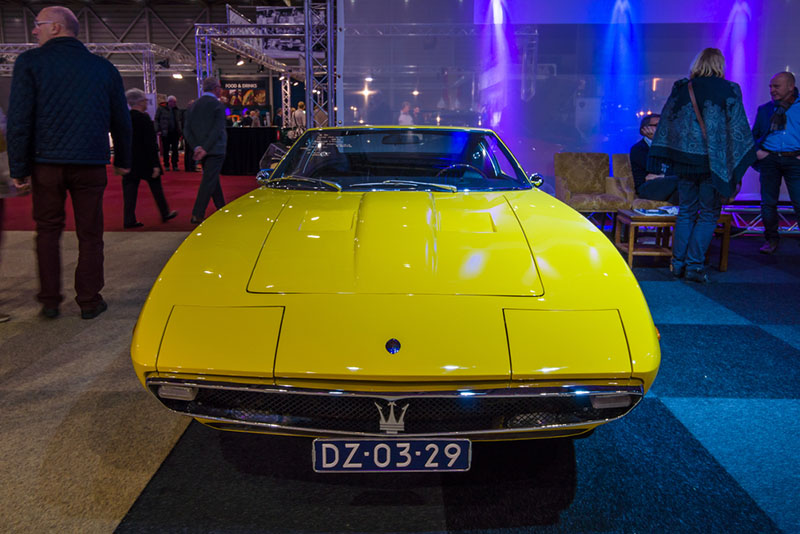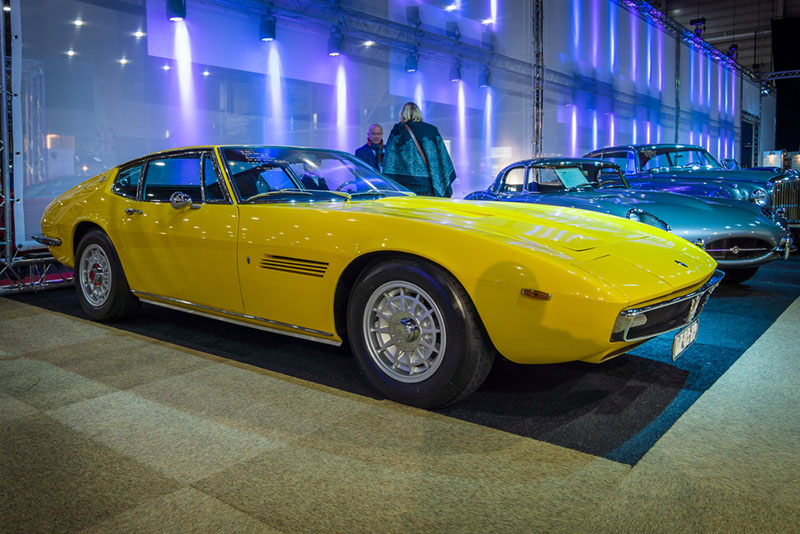Sell my Classic Maserati Ghibli
Maserati Ghibli is the name of three different cars produced by Italian manufacturer Maserati
These included:
- The AM115
- V8 grand tourer
- The AM336
- The M157
Ghibli is the name for the hot dry south-westerly wind of the Libyan desert.
1967 Maserati Ghibli
The 1967 Maserati Ghibli was produced between 1967 and 1973.
It was assembled in Modena, Italy and desgned by Giorgetto Giugiaro at Ghia
It was a Grand tourer in a 2-door fastback coupé and 2-door spyder
It had a Front-engine and rear-wheel-drive with a 4.7 L V8 and 4.9 L V8 Engine.
It had 5-speed ZF manual and was a 3-speed automatic. It’s Wheelbase was 2,550 mm (100.4 in), it’s length was 4,700 mm (185.0 in), a width of 1,790 mm (70.5 in) a Height of 1,160 mm (45.7 in) and a Kerb weight of 1,650–1,770 kg (3,638–3,902 lb).
It’s successor was the Maserati Khamsin and the Maserati Bora.
The original Ghibli (Tipo AM115) is a two-door, 2+2 V8-engined grand tourer.

History
The Ghibli was first unveiled as a 2-seater prototype at the November 1966 Turin Motor Show.
Its steel body, characterized by a low, shark-shaped nose, was designed by a young Giorgetto Giugiaro
The car featured:
- Pop-up headlamps
- Leather front sport seats
- Alloy wheels
Two rear seats consisting of nothing more than a cushion without a backrest were added to the production run
The Ghibli to be marketed as a 2-door 2+2 fastback coupé
Deliveries started in March of 1967.
The car was powered by a front placed quad-cam 4.7 L, 310 PS (228 kW; 306 bhp) dry sump V8 engine mated to a five-speed manual, with a three-speed automatic optional.
It had a 0-60 mph time of 6.8 seconds,
It had a top speed of 250 km/h (155 mph).
Ghibli Spyder
Spyder
The 2-seat Ghibli Spyder went into production in 1969
Its convertible top folded under a flush fitting body-colour tonneau cover behind the front seats. A retractable hardtop was available as an option.
Ghibli SS
The Ghibli SS was released in 1969.
Its 4.9-litre engine was stroked 4 mm to displace 4930 cc, and put out 335 PS (246 kW; 330 bhp).
Its top speed of 280 km/h (174 mph) made it the fastest Maserati road car ever produced.
SS-engined cars have additional /49 designation (ex. AM115/49).
Production
In all, 1,170 coupés and 125 Spyders (including 25 Spyder SS) were produced.
The Ghibli went out of production in 1973; it was succeeded the following year by the Bertone-designed Khamsin.
Specifications
The Ghibli used a tubular frame with a separate body.
Front suspension used double wishbone type, coaxial dampers and coil springs, and an anti-roll bar.
At the rear there was:
- A live axle on semi-elliptic springs
- A single longitudinal torque arm
- Hydraulic dampers
- An anti-roll bar
Magnesium wheels were standard
Originally fitted with Pirelli Cinturato 205 VR15 tyres (CN72)
Borrani wire wheels were optional.
The car consumed copious volumes of fuel, but Maserati fitted the car with two independent 50 L
Maserati Ghibli
The Maserati Ghibli was produced between 1992 and 1998. Designed by Marcello Gandini.
It was a Grand tourer with a 2-door coupé body style with a Front-engine and rear-wheel-drive.
It related to the Maserati Biturbo and had a:
- 2.0 L V6 (twin-turbocharged petrol) and 2.8 L V6 (twin-turbocharged petrol) engine
- 5-speed ZF manual transmission,
- 6-speed Getrag manual and 4-speed automatic
It had a Wheelbase of 2,514 mm (99.0 in) and a Length of 4,223 mm (166.3 in) and a Width of 1,775 mm (69.9 in). It’s height was 1,300 mm (51.2 in) and it had a Kerb weight of 1,365–1,406 kg (3,009–3,100 lb).
Maserati 3200 GT
The Ghibli name was resurrected with the unveiling of the 1992 Ghibli (Tipo AM336)
It was a two-door, four-seater coupé with twin-turbo V6 engines
Like the V8 Maserati Shamal, it was an evolution of the previous Biturbo coupés; the doors, interior, and basic bodyshell were carried over from the Biturbo.
History
The Ghibli was launched at the 62nd Turin Motor Show in April 1992.
The Ghibli was powered by:
- Updated 24-valve Biturbo engines
- A 2.0-litre V6 coupled to a six-speed manual transmission for the Italian market
- A 2.8-litre V6 for export
- First with a 5-speed manual, then from 1995 with the 6-speed.
- A 4-speed automatic was optional.
The coupé was built for luxury as well as performance
It’s interior featured Connolly leather upholstery and burl elm trim.
1994 Ghibli
At the 1994 Geneva Motor Show, Maserati launched an updated Ghibli.
It had:
- A refreshed interior
- New wing mirrors
- Wider and larger 17″ alloy wheels of a new design
- Fully adjustable electronic suspension and ABS brakes were added
The Ghibli Open Cup single-make racing car was announced in late 1994.
1995
Two sport versions were introduced in 1995. T
First was the Ghibli Kit Sportivo,
It had:
- Wider tyres on OZ “Futura III” split-rim wheels
- Specific springs
- Dampers
- Anti-roll bars
Ghibli Cup
The Ghibli cup debuted at the December 1995 Bologna Motor Show.
it mounted a 2-litre engine upgraded to 330 PS (243 kW; 325 hp).
The Ghibli Cup had the highest ever per litre power output of any street legal car
Chassis upgrades included:
Tweaked suspension
Brembo brakes
Visually the Cup was recognizable from its 5-spoke split-rim Speedline wheels and badges on the doors.
Only four paint colours were available:
- Red
- White
- Yellow
- French blue.
The sporty theme continued in the Cup’s cabin with:
- Black leather
- Carbon fibre trim
- Aluminium pedals
- MOMO steering wheel
Ghibli GT
A second round of improvements resulted in the Ghibli GT in 1996.
It was fitted with:
- 7-spoked 17″ alloy wheels
- Black headlight housings
- Suspension and transmission modifications
To celebrate the world record Maserati made 60 special edition Ghiblis called:
- The Ghibli Primatist
It featured special:
- Ultramarine blue paintwork
- An interior trimmed in two-tone blue/turquoise leather and polished burr walnut.
Production of the second generation Ghibli ended in summer 1998. It was replaced in the Maserati range by the 3200 GT.
Ghibli Open Cup
A single-make racing series for the Ghibli, the Open Cup, was run two seasons—1995 and 1996. Twenty-five Ghibli Open Cup racing cars were prepared. After the end of the 1995 racing season, several of the original 23 cars were used in national GT events. Today the Ghibli Open Cup is highly sought after by collectors.
Ghibli GT
The Ghibli had:
- Unibody steel construction
- A conventional layout of longitudinally mounted engine
- Rear-wheel drive
The Suspension was of the MacPherson strut type at the front and semi-trailing arms at the rear.
It had:
- Coil springs
- Double-acting dampers
- Anti-roll bars on both axles
- The differential and rear suspension arms were supported by a bushing-insulated subframe
- Brakes were vented discs on all four wheels, and steering was servo-assisted rack and pinion.
The engine was the latest evolution of Maserati’s 90 degree all-aluminium, DOHC 24-valve V6 engine
It was:
- Fitted with two water-cooled IHI turbochargers and two air-to-air intercoolers, one per each cylinder bank.
- Weber-Magneti Marelli IAW electronic fuel injection and ignition was used
- The gearbox was a Getrag-supplied 6-speed manual from the Shamal on 2-litre cars,
- 2.8 litre cars initially used a 5-speed ZF unit and were updated with the Getrag gearbox in 1995.
- At the rear axle there was Maserati’s “Ranger” Torsen limited slip differential from the Biturbo, with an added oil cooler.
It was able to do 0–100 km/h
Production Numbers
- Ghibli 2.0 1992–98 1,996 cc 306 PS (225 kW; 302 hp) at 6,250 rpm 373 N·m (275 lb·ft) at 4,250 rpm 255 km/h (158 mph) 5.7 s Italy and Europe only 1,157
- Ghibli 2.8 1992–98 2,790 cc 284 PS (209 kW; 280 hp) at 6,000 rpm 413 N·m (305 lb·ft) at 3,500 rpm 250 km/h (155 mph) 6.0 s 1,063
- Ghibli Cup 1996–97 1,996 cc 330 PS (243 kW; 325 hp) at 6,500 rpm 373 N·m (275 lb·ft) at 4,000 rpm 270 km/h (168 mph) 5.6 s 57
- Ghibli Primatist 1996–97 1,996 cc 306 PS (225 kW; 302 hp) at 6,250 rpm 373 N·m (275 lb·ft) at 4,250 rpm 255 km/h (158 mph) 5.7 s 60
Ghibli (M157)
Maserati Ghibli
It was assembled in Grugliasco, Turin
It was a:
- Mid-size luxury / Executive car (E) with a 4-door sedan body style
- Front-engine, rear-wheel-drive / four-wheel-drive
It was related to the Maserati Quattroporte with a:
-
- 3.1 L V6 (twin-turbocharged petrol) and 3.0 L V6 (turbocharged diesel)
- 8-speed ZF automatic transmission.
- Wheelbase was 2,998 mm (118.0 in) with a length of 4,971 mm (195.7 in) and a width of 2,100 mm (82.7 in) and a height of 1,461 mm (57.5 in) and a Kerb weight of 1,810 kg (3,990 lb)
It’s Predecessor was the Maserati 430.
Maserati Ghibli (M157)
The current third generation Ghibli (Tipo M157) was unveiled at the 2013 Shanghai motor show
The Ghibli is offered with:
- Three different 3.0-litre V6 engines:
- A twin-turbocharged 330 PS (240 kW; 330 hp)
- 410 PS (300 kW; 400 hp) petrol
- 275 PS (202 kW; 271 hp) turbodiesel
It was the first Maserati production car to be powered by a diesel engine.
An eight-speed automatic transmission was standard on all models
All wheel drive is available with the most powerful V6.

